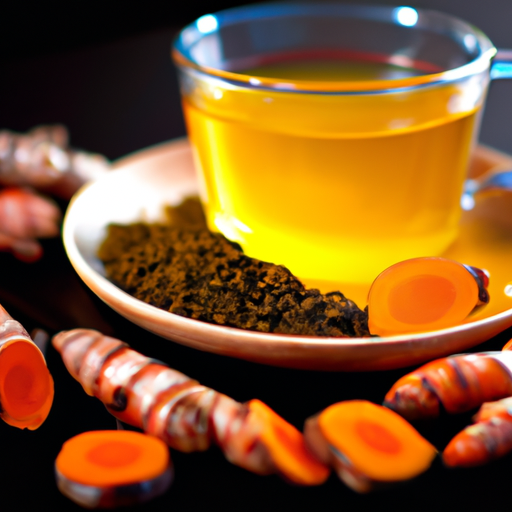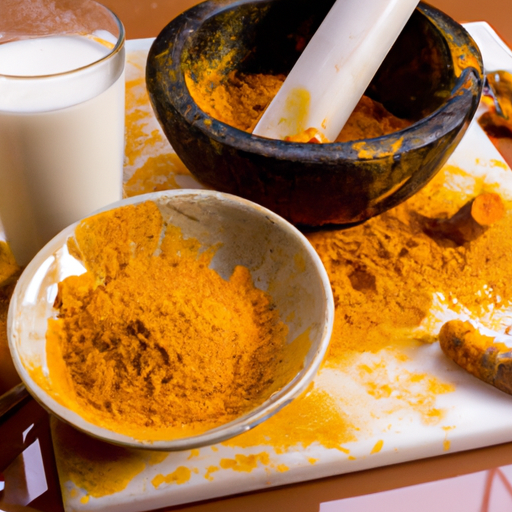Hello, tea enthusiasts! I am excited to introduce to you my latest passion – fresh turmeric tea. This delightful beverage not only warms and comforts the soul but also offers numerous health benefits that have been recognized for generations in traditional medicine.
Turmeric is a root that belongs to the ginger family and has been used for its medicinal properties in India and other parts of Asia for thousands of years. The active ingredient in turmeric, curcumin, has anti-inflammatory and antioxidant properties that can help reduce inflammation in the body, improve brain function, and even potentially prevent cancer. Plus, it’s just downright tasty!
So let me show you how to make your own cup of fresh turmeric tea from scratch right here on Utube.
Key Takeaways
- Fresh turmeric is more potent than dried turmeric and offers a variety of health-boosting properties due to its high content of curcumin.
- Turmeric tea can be brewed in various ways depending on taste preferences and can be enhanced with ingredients like honey or lemon juice.
- Turmeric tea has many health benefits, including reducing inflammation, boosting immunity, and improving brain function and heart health.
- While incorporating turmeric into the diet can be beneficial, precautions should be taken, such as consulting with a doctor before consumption and avoiding excessive intake for pregnant women and those with allergies or taking certain medications.
Health Benefits of Fresh Turmeric Tea
So, if you’re looking for a natural way to boost your immune system and reduce inflammation, fresh turmeric tea is definitely worth trying! Turmeric has been used in traditional medicine for centuries due to its powerful anti-inflammatory and antioxidant properties. Additionally, consuming turmeric regularly may also improve brain function and lower the risk of heart disease.
There are many recipes using fresh turmeric, but making a simple tea is one of the easiest ways to incorporate it into your daily routine. Drinking turmeric tea regularly may help support your immune system and improve overall health.
Now let’s take a look at the ingredients and equipment needed to make this delicious drink.
Ingredients and Equipment Needed
To prepare this potent potion, you’ll require a few flavorful fixings and some fundamental tools.
First and foremost, you’ll need high-quality turmeric root. There are two main types of turmeric: fresh and dried. Fresh turmeric is more potent than its dried counterpart, so try to get your hands on the freshest possible root. You can find it at your local farmers’ market or health food store.
In addition to the turmeric root, you will also need utensils such as a cutting board, a sharp knife or grater for shredding the root, and a small pot for boiling water.
To add some flavor to your tea, you can include other ingredients like honey or lemon juice depending on your preferences.
With these items in hand, we can move on to preparing the turmeric root for our tea!
Preparing the Turmeric Root
Now, it’s time to get your hands dirty and start preparing the turmeric root by peeling off the skin using a sharp knife or grater. You can also use a spoon to scrape off the skin if you don’t want to risk cutting yourself with a knife.
Once you’ve peeled off the skin, rinse the turmeric root thoroughly under cold running water.
After rinsing, slice the turmeric root into thin pieces or grate it using a fine grater. The smaller and thinner you slice or grate it, the more surface area will be exposed when boiling in water, which means more of its nutrients will be released into your tea.
Boiling is an option for those who prefer their tea to have a stronger flavor and richer color. Using fresh turmeric in cooking has many benefits including reducing inflammation in the body and aiding digestion.
So, let’s move on to brewing our fresh turmeric tea!
Brewing the Tea
Once the turmeric root has been prepared, it’s time to steep it in hot water to create a fragrant and flavorful cup of tea that will knock your socks off! There are various brewing techniques you can use depending on your taste preferences. Here’s a simple method that I find works well for me:
First, bring four cups of water to a boil in a pot. While waiting for the water to boil, add one tablespoon of grated or finely chopped turmeric root into a tea infuser or directly into the pot. You can also add other spices such as ginger or cinnamon at this point if you’d like. Once the water is boiling, turn off the heat and let the mixture steep for 10-15 minutes, depending on how strong you want your tea to be. After steeping, remove the infuser or strain out any chunks of turmeric using a fine mesh sieve.
There are many flavor variations you can try when brewing fresh turmeric tea. For example, adding lemon juice or honey can give it an extra tangy kick while coconut milk can make it creamier and richer. You could also experiment with different types of sweeteners like maple syrup or agave nectar. The possibilities are endless! With these tips in mind, go ahead and brew yourself a cup of fresh turmeric tea that suits your taste buds perfectly.
Now that we’ve brewed our perfect cup of fresh turmeric tea, we’re ready to move onto straining and serving it up!
Straining and Serving
After steeping for 10-15 minutes, it’s time to strain out any remaining turmeric chunks and serve the fragrant tea in your favorite mug.
To do this, you can use a fine mesh strainer or cheesecloth. Pour the tea through the strainer into another container or directly into your mug. Make sure to press down on the turmeric with a spoon to ensure all of the liquid is extracted.
When it comes to serving suggestions, adding a splash of honey or lemon juice can enhance the flavor profile of your turmeric tea. You can also garnish with fresh mint leaves or cinnamon sticks for an added touch of aroma and visual appeal.
Now that you have successfully strained and served your fresh turmeric tea, let’s move on to some tips for making the perfect brew every time!
Tips for Making the Perfect Turmeric Tea
Now that we’ve learned how to strain and serve our freshly brewed turmeric tea, let’s talk about some tips for making the perfect cup.
First and foremost, it’s important to use high-quality ingredients. This means using fresh turmeric root instead of powdered turmeric, and choosing organic ingredients whenever possible.
Another tip is to experiment with different variations of turmeric tea. You can add additional herbs and spices like ginger or cinnamon for added flavor and health benefits. Additionally, you can adjust the amount of turmeric used depending on your personal taste preferences.
It’s also important to consider the best time to drink your turmeric tea. Some people prefer drinking it in the morning as a way to jumpstart their day, while others enjoy sipping on a warm cup before bedtime for its relaxing properties. Ultimately, the best time for you will depend on your individual needs and preferences.
As we continue exploring the benefits of turmeric tea, it’s important to keep in mind any potential health precautions that may apply.
Health Precautions
As I delve into the topic of health precautions related to turmeric usage, it’s important to note that this spice has some potential side effects. These include upset stomach, nausea, and a risk of bleeding.
It’s advisable to consult with a doctor before incorporating turmeric into your diet if you have pre-existing medical conditions or are taking certain medications.
Possible Side Effects
Be mindful of possible side effects, like stomach upset or diarrhea, when you indulge in the vibrant and aromatic turmeric tea. Although turmeric has many health benefits, it can also cause some unwanted reactions in certain individuals.
Here are a few things to keep in mind before consuming turmeric tea:
- Turmeric may interact with certain medications such as blood thinners and diabetes medication.
- Pregnant women should avoid excessive consumption of turmeric as it may stimulate the uterus and cause contractions.
- Some people may be allergic to turmeric and experience symptoms such as hives or difficulty breathing.
- High doses of turmeric may lead to nausea, dizziness, or dehydration.
It’s always recommended that you consult with a doctor before introducing anything new into your diet or supplement routine. In the case of incorporating fresh turmeric tea, it’s important to take these precautions seriously and proceed with caution for optimal health outcomes.
Consultation with a Doctor
It’s crucial to consult with your doctor before incorporating turmeric tea into your diet, as it may interact with certain medications and cause unwanted side effects. Your doctor can help you assess both the benefits and risks of consuming turmeric tea based on your specific health conditions and needs. They can also recommend an appropriate dosage and frequency that suits you best.
Aside from consulting a doctor, it’s also important to explore alternative remedies and compare turmeric tea with other teas. For instance, green tea has been known for its antioxidant properties, while chamomile tea is popular for its calming effect. While each type of tea has unique benefits, fresh turmeric offers a variety of health-boosting properties due to its high content of curcumin.
By understanding the differences between these teas, you can make an informed decision about which one is best suited for your needs. Now let’s move on to exploring other uses for fresh turmeric!
Other Uses for Fresh Turmeric
Let’s explore the various ways fresh turmeric can enhance our daily routines beyond just making tea. Fresh turmeric is a versatile ingredient that can be used in many cooking recipes, adding a unique flavor and vibrant color to dishes. It pairs well with vegetables, rice, and meats.
One of my favorite ways to use fresh turmeric is by making a golden milk latte by mixing it with coconut milk and honey.
In addition to cooking recipes, fresh turmeric has been used for centuries as a natural remedy for various health conditions. Its anti-inflammatory properties make it beneficial for reducing pain and inflammation caused by arthritis or other chronic diseases. It also aids digestion and boosts the immune system.
Incorporating fresh turmeric into your daily routine can have numerous benefits for your overall health and wellbeing. Now let’s move on to the next section where we’ll learn how to make fresh turmeric tea through an informative youtube tutorial.
YouTube Tutorial on Making Fresh Turmeric Tea
So, I just watched a YouTube tutorial on how to make fresh turmeric tea and it was really interesting! The video went over the benefits of drinking turmeric tea, which include reducing inflammation and boosting immunity.
It also showed the process of making the tea and emphasized the importance of incorporating healthy habits into our daily routines. Overall, I feel encouraged to try making turmeric tea at home and incorporate this healthy habit into my life.
Recap of Benefits and Process
To review the benefits and process, we’ll quickly recap how to make a delicious and healthy cup of fresh turmeric tea.
First, let’s talk about the benefits. Fresh turmeric root contains powerful antioxidants and anti-inflammatory compounds, making it an excellent addition to any diet. Consuming turmeric regularly has been linked to improved brain function, reduced risk of heart disease, and even potential cancer-fighting properties.
Now for the brewing process overview. Start by boiling water in a small pot or kettle. While the water is heating up, grate or finely chop a small piece of fresh turmeric root (about an inch or two). Once the water has boiled, pour it over the grated turmeric in a mug and let steep for 5-10 minutes. Add honey or lemon juice for taste if desired. Sip slowly and enjoy!
Incorporating this simple habit into your daily routine can have numerous health benefits in the long run. It’s important to incorporate healthy habits like drinking fresh turmeric tea into our daily routines to improve overall well-being.
Next, we’ll discuss other ways to promote a healthier lifestyle without feeling overwhelmed by strict rules or diets.
Importance of Incorporating Healthy Habits
Incorporating healthy habits into our daily routines is crucial for improving our overall well-being and creating a happier, healthier lifestyle. The benefits of healthy habits are numerous, including increased energy levels, improved mental clarity and focus, better sleep quality, and reduced stress levels.
By making small changes to our daily routines, such as incorporating exercise or meditation into our mornings or swapping out unhealthy snacks for nutritious ones, we can create sustainable habits that will lead to long-term health improvements.
Creating a sustainable routine is key when it comes to maintaining healthy habits. It’s important to start small and gradually build up to more challenging goals. Consistency is also crucial for success – instead of trying to make drastic changes all at once, it’s better to focus on making small but consistent improvements over time. By doing so, we can create lasting habits that become second nature and ultimately lead us towards a healthier lifestyle.
With these healthy habits in place, we can now move onto the next step: encouraging others to try making fresh turmeric tea at home!
Encouragement to Try Making Turmeric Tea at Home
Let’s give ourselves a chance to enjoy a warm and healthy drink that boasts numerous benefits, shall we? Making turmeric tea at home isn’t only easy, but it also provides you with an opportunity to explore new recipes while reaping the benefits of turmeric.
Here are some reasons why you should try making fresh turmeric tea at home:
- It’s a great way to incorporate anti-inflammatory and antioxidant properties into your diet.
- Turmeric has been known to improve brain function and lower the risk of heart disease.
- Making your own tea allows you to customize it to your taste preferences and experiment with different ingredients.
So why not grab yourself some fresh turmeric root and start exploring turmeric recipes today?
Frequently Asked Questions
Is it safe to consume turmeric tea if you are taking certain medications?
If I am taking certain medications, I should be cautious about consuming turmeric tea due to potential drug interactions. However, if not on medication, turmeric tea can provide numerous health benefits such as anti-inflammatory properties and aiding digestion.
How long can you store fresh turmeric root before it goes bad?
I know what you’re thinking: "How long can I store fresh turmeric root before it goes bad?"Well, the storage duration depends on a few factors. Look out for signs of softness or mold to determine freshness indicators. Generally, fresh turmeric can last up to 3 weeks when stored properly in the refrigerator.
Can you add other ingredients to the turmeric tea for flavor or added health benefits?
Yes, you can add other ingredients to turmeric tea for flavor and added health benefits. Some popular turmeric tea variations include adding ginger, cinnamon, honey, or lemon. These additives can provide anti-inflammatory and antioxidant properties to the already beneficial turmeric tea.
Can you reuse the same turmeric root for multiple cups of tea?
Yes, I can reuse the same turmeric root for multiple cups of tea. It helps with turmeric root preservation and provides added benefits to the tea. Just add more water and boil again for a new cup.
How much turmeric should you use per cup of water when making the tea?
Did you know that turmeric tea benefits include reducing inflammation and boosting immunity? For a perfect cup, I recommend using 1 tsp of grated turmeric per cup of water. Experiment with variations like adding ginger or honey for added flavor.
Conclusion
Well, that’s all for now! I hope you’ve found this tutorial helpful in making fresh turmeric tea. As someone who’s been drinking this tea for years, I can attest to its many health benefits and delicious taste.
One interesting statistic to note is that a study published in the Journal of Medicinal Food found that daily consumption of turmeric over an eight-week period improved mood and reduced symptoms of depression in participants. This just goes to show how powerful this little root can be!
Remember, when making your own turmeric tea, it’s important to use fresh ingredients and follow the steps carefully to ensure the best possible flavor and health benefits.
And if you’re not a fan of drinking hot beverages, there are plenty of other ways to incorporate fresh turmeric into your diet – from adding it to smoothies and curries to using it as a natural dye for fabrics or Easter eggs.
So get creative and enjoy all the wonderful benefits that this amazing spice has to offer!










